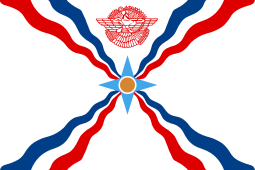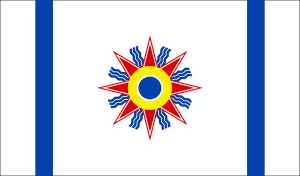List of Assyrian settlements
The following is a list of historical and contemporary Assyrian settlements in the Middle East. This list includes settlements of Assyrians from Southeastern Turkey who left their indigenous tribal districts in Hakkari (or the historical Hakkari region), Sirnak and Mardin province[2] due to torment, violence and displacement by the Ottomans in the First World War. Many Assyrians from Urmia, Iran were also affected and as such have emigrated and settled in other towns. Resettling again occurred during the Simele massacre in northern Iraq, perpetrated by the Iraqi military coup in the 1930s, with many fleeing to northeastern Syria.[3]
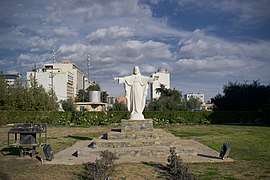
| Assyrian people |
|---|
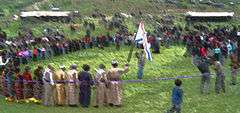 |
| Culture |
| Music |
| Language |
| Cuisine |
| Folk Dance |
| Religion |
| Clothing |
| Settlements |
| Tribes |
Most modern resettlement is located in Iraq,[4] Syria and Iran in the cities of Baghdad, Habbaniyah, Kirkuk, Duhok, Al-Hasakah, Tehran and Damascus. Few Assyrian settlements exist in Turkey today and also in the Caucasus. The exodus to the cities or towns of these aforementioned countries occurred between late 1910s and 1930s.[5][6] After the Iraq War in 2003, a number of Assyrians in Baghdad relocated to Northern Iraq, repopulating parts of Iraqi Kurdistan, in what they now call the "Assyrian homeland".[7] Many others have immigrated to North America, Europe and Australia, especially in the late 20th century and 21st century.[8] Currently, there are a number of settlements on this list that have been abandoned due to persecution, conflict, and other causes.[9]
Iraq
Baghdad Province
| Settlement | Aramaic | Province | District | Note(s) |
|---|---|---|---|---|
| Dora | ܕܘܿܪܐ | Baghdad | Al Rashid | 1,500 Christians, mostly adherents of the Assyrian Church of the East and Chaldean Catholic Church, inhabit Dora as of December 2014.[10] Before the Iraq War Dora was home to 150,000 Christians.[11] |
Dohuk Province
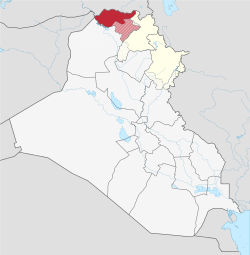
| Settlement | Aramaic | Province | District | Note(s) |
|---|---|---|---|---|
| Araden[12] | ܐܪܕܢ | Dohuk | Amadiya | 35 Assyrian families inhabit Araden as of May 2004[13] |
| Enishke | ܐܝܢܫܟܐ | Dohuk | Amadiya | 30 Assyrian families inhabit Enishke as of May 2004[13] |
| Sarsing[14] | ܣܪܣܢܓ | Dohuk | Amadiya | 150 Assyrian families inhabit Sarsing as of May 2004[15] |
| Badarash | ܒܪܕܪܐܫ | Dohuk | Amadiya | 40 Assyrian families inhabit Badarash as of May 2004[13] |
| Amadiya[16] | ܥܡܝܕܝܐ | Dohuk | Amadiya | |
| Baz | ܒܐܙ | Dohuk | Amadiya | 10 Assyrian families inhabited Baz in May 2004.[17] 40 Christian and Muslim families inhabit Baz as of June 2011[18] |
| Bebadi | ܒܝܬ ܒܥܕܝ | Dohuk | Amadiya | 30 Assyrian families inhabit Bebadi as of May 2004[16] |
| Belejane | ܒܠܝܓ̰ܢܐ | Dohuk | Amadiya | 15 Assyrian families inhabit Belejane as of May 2004[19] |
| Belmand | ܒܠܡܢܕ | Dohuk | Amadiya | 50 Assyrian families inhabit Belmand as of May 2004[20] |
| Beqolke | ܒܹܩܘܠܟܐ | Dohuk | Amadiya | 74 Assyrians inhabited Beqolke in 1957; 7 Assyrian families inhabited Beqolke in 1978; 4 Assyrian families inhabit Beqolke as of 1991[21] |
| Benatha | ܒܹܢܬܐ | Dohuk | Amadiya | 8 Assyrian families inhabit Benatha as of May 2004[13] |
| Beth Shmayaye | ܒܝܬ ܫܡܝܝܐ | Dohuk | Amadiya | |
| Beth Tanura | ܒܝܬ ܬܢܘܪܐ | Dohuk | Amadiya | |
| Chalek | Dohuk | Amadiya | 10 Assyrian families inhabit Chalek as of May 2004[17] | |
| Chem Rabatke | ܟ̰ܡ ܪܒܬܟܐ | Dohuk | Amadiya | |
| Dawodiya | ܕܘܘܕܝܐ | Dohuk | Amadiya | |
| Dehi | ܕܗܐ | Dohuk | Amadiya | 20 Assyrian families inhabit Dehi as of 1991 |
| Dere | ܕܝܪܐ | Dohuk | Amadiya | 323 Assyrians inhabited Dere in 1957;[22] 250 Assyrians inhabited Dere in 1988;[22] 25 Assyrian families inhabit Dere as of May 2004[19] |
| Derishke | ܕܝܪܫܟܐ | Dohuk | Amadiya | 20 Assyrian families inhabit Derishke as of May 2004[23] |
| Doreeh | ܕܘܪܗ | Dohuk | Amadiya | 30 Assyrian families inhabit Dore as of May 2004[24] |
| Eqri | ܐܩܪܝ | Dohuk | Amadiya | |
| Eyat | ܐܝܬ | Dohuk | Amadiya | 169 Assyrians inhabited Eyat in 1957; 19 Assyrian families inhabit Eyat as of 2013 [25] |
| Hayes | ܗܝܤ | Dohuk | Amadiya | |
| Hezany | ܗܝܙܢܐ | Dohuk | Amadiya | 27 Assyrian families inhabit Hezany as of 1991 |
| Jadide | ܓ̰ܕܝܕܐ | Dohuk | Amadiya | |
| Jelek | Dohuk | Amadiya | 519 Assyrians inhabited Jelek in 1957; 62 Assyrian families inhabit Jelek as of 2011 [26] | |
| Jole | ܫ̰ܘܠܐ | Dohuk | Amadiya | |
| Kani Balavi | ܟܢܝ ܒܠܦ̮ܐ | Dohuk | Amadiya | 15 Assyrian families inhabit Kani Balavi as of May 2004[27] |
| Khalilane | ܚܠܝܠܢܐ | Dohuk | Amadiya | 20 Assyrian families inhabit Khalilane as of May 2004[28] |
| Komany | ܟܘܡܢܐ | Dohuk | Amadiya | 20 Assyrian families inhabit Komany as of May 2004[19] |
| Mangesh | ܡܢܓܫܐ | Dohuk | Amadiya | 1195 Assyrians inhabited Mangesh in 1947; 959 Assyrians inhabited Mangesh in 1965[29] |
| Margajiya | ܡܪܓܐ ܓ̰ܝܐ | Dohuk | Amadiya | |
| Maye | ܡܝܐ | Dohuk | Amadiya | 10 Assyrian families inhabit Maye as of May 2004[23] |
| Meristek | ܡܝܪܣܬܟ | Dohuk | Amadiya | |
| Meroge | ܡܝܪܘܓܐ | Dohuk | Amadiya | |
| Meze | ܡܝܙܐ | Dohuk | Amadiya | |
| Mosaka | ܡܘܣܵܟܵܐ | Dohuk | Amadiya | |
| Sardarawa | ܣܪ ܕܪܒܐ | Dohuk | Amadiya | |
| Sardashte | ܣܪܐ ܕܫܬܐ | Dohuk | Amadiya | |
| Sikrine | ܣܟܪܝܢܐ | Dohuk | Amadiya | |
| Tashish | ܬܫܝܫ | Dohuk | Amadiya | 163 Assyrians inhabited Tashish in 1957.[30] |
| Aqrah | ܥܩܪܐ | Dohuk | Aqrah | |
| Nohawa | ܢܘܗܒܐ | Dohuk | Aqrah | |
| Babelo | ܒܵܒܠܘ | Dohuk | Dohuk | |
| Bagerat | ܒܓܝܪܬ | Dohuk | Dohuk | |
| Dohuk | ܢܘܗܕܪܐ | Dohuk | Dohuk | |
| Gondekosa | ܓܘܢܕ ܟܘܣܐ | Dohuk | Dohuk | |
| Korygavana | ܟܘܪܝܓܦ̮ܢܐ | Dohuk | Dohuk | |
| Zawita | ܙܘܝܬܐ | Dohuk | Dohuk | |
| Avzrog | ܐܒܙܪܘܓ | Dohuk | Semel | |
| Bajed Berav | ܒܓ̰ܕ ܒܝܪܦ̮ | Dohuk | Semel | |
| Bajed Kindal | ܒܓ̰ܕ ܟܝܢܕܠ | Dohuk | Semel | |
| Bakhetme | ܒܚܬܡܐ | Dohuk | Semel | |
| Bakhloja | ܒܚܠܘܓ̰ܐ | Dohuk | Semel | |
| Jambor | ܓ̰ܡܒܘܪ | Dohuk | Semel | |
| Mar Yakoo | ܡܪܝ ܝܥܩܘܒ | Dohuk | Semel | 79 Assyrian families inhabit Mar Yakoo as of 2011[31] |
| Simele | ܣܡܠܐ | Dohuk | Semel | |
| Sheze | ܫܝܙ | Dohuk | Semel | Inhabited as of November 2011[32] |
| Shkafte | ܫܟܦ̮ܬܐ | Dohuk | Semel | |
| Surka | ܨܘܪܟܐ | Dohuk | Semel | |
| Berseve | ܒܝܪܣܦ̮ܐ | Dohuk | Zakho | |
| Dashtatakh | ܕܫܬܟ | Dohuk | Zakho | |
| Dera Shish | ܕܝܪܐ ܫܝܫ | Dohuk | Zakho | 250 Assyrians inhabited Dera Shish in 1976; 8 Assyrian families inhabit Dera Shish as of 2011[33] |
| Levo | ܠܝܦ̮ܘ | Dohuk | Zakho | |
| Marga | ܡܪܓܐ | Dohuk | Zakho | |
| Margasor | ܡܝܪܓܐ ܣܘܪ | Dohuk | Zakho | |
| Navkandala | ܢܐܦ̮ ܟܢܕܠܐ | Dohuk | Zakho | |
| Piraka | ܦܝܪܟܐ | Dohuk | Zakho | |
| Qarawula | ܩܪܘܠܐ | Dohuk | Zakho | 334 Assyrians inhabited Qarawula in 1957; inhabited by 66 Assyrian families in 1975. Inhabited as of November 2011.[34] |
| Sharanesh | ܫܪܢܘܫ | Dohuk | Zakho | |
| Zakho | ܙܟܼܘ | Dohuk | Zakho | A Chaldo-Assyrian tribe, associated with Catholic Assyrians. It has been inhabited by Assyrians since the 5th century. Assyrians from Hakkari, Turkey, have resettled there to escape persecution and violence by Ottoman Turks in the early 20th century. |
Erbil Province
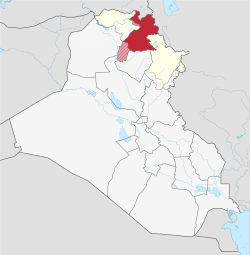
| Settlement | Aramaic | Province | District | Note(s) |
|---|---|---|---|---|
| Ankawa | ܥܢܟܒܐ | Erbil | Erbil | |
| Armota | ܐܪܡܥܘܛܐ | Erbil | Koya | |
| Batas | ܒܬܣ | Erbil | Shaqlawa | |
| Bidial | ܒܕܝܠ | Erbil | Barzan | 5 Assyrian families inhabit Bidial as of 1991[35] |
| Darbandokeh | ܕܪܒܢܕܘܟܐ | Erbil | Shaqlawa | |
| Diana | ܕܝܢܐ | Erbil | Soran | |
| Harir | ܗܪܝܪ | Erbil | Shaqlawa | |
| Hawdiyan | Erbil | Shaqlawa | ||
| Hinari | Erbil | |||
| Rowanduz | ܪܘܢܕܝܙ | Erbil | Soran | |
| Seerishmi | ܣܝܪܫܡܝ | Erbil | ||
| Shaqlawa | ܫܩܠܒܐ | Erbil | Shaqlawa | |
| Qalata | ܩܠܬܐ | Erbil |
Kirkuk Governorate
| Settlement | Aramaic | Province | District | Note(s) |
|---|---|---|---|---|
| Kirkuk | ܟܪܟ | Kirkuk | Around 1,605 Assyrians lived there up until 1957 |
Nineveh Province
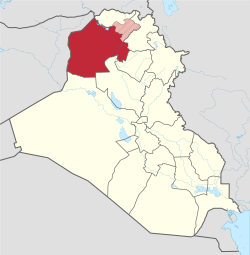
| Settlement | Aramaic | Province | District | Note(s) |
|---|---|---|---|---|
| Mosul | ܡܘܨܠ | Nineveh | Al-Mosul | Assyrians have inhabited the city of Mosul for over a millennia.[36] Population records show a continuous Assyrian presence in Mosul from at least the 16th century.[37][38] Assyrians from Mosul (known as Mawasli) are Arabic-speaking, their dialect belongs to North Mesopotamian Arabic.[39][40] Most belong to Syriac churches; the Syriac Orthodox Church, the Syriac Catholic Church, and the Chaldean Catholic Church.[41][42] A few having converted from Syriac churches to Protestantism starting in the mid 19th century.[43] The majority of Mosul Assyrians migrated south to Baghdad in the 1960s due to political unrest and persecution, (1959 Mosul Uprising).[44] However, Assyrians continued to live in Mosul until being fully driven out by ISIS in 2014.[45] After the recapturing of Mosul, only a few Assyrian families have returned back to the city.[46] |
| Ain Sifni | ܥܝܢ ܣܦܢܐ | Nineveh | Shekhan | |
| Alqosh | ܐܠܩܘܫ | Nineveh | Tel Keppe | Ancient Assyrian tribe associated with Chaldean Christians (Catholic Assyrians). It was also settled by Assyrians from Hakkari after 1914. |
| Bandwaya | Nineveh | Tel-Keppe | ||
| Bakhdida | ܒܟܕܝܕܐ | Nineveh | Al-Hamdaniya | Was an ancient, pre-Christian Assyrian town filled with historical artifacts. Always had a significant Christian minority in modern times. Was also settled by Assyrians from southeastern Turkey. |
| Balawat | ܒܝܬ ܠܒܬ | Nineveh | Al-Hamdaniya | |
| Baqofah | ܒܬܢܝܐ | Nineveh | Tel Keppe | |
| Bartella | ܒܪܬܠܐ | Nineveh | Al-Hamdaniya | Home to Oriental Orthodox Syriacs and Eastern Catholic Syriacs. Most emigrated out of the town due to Islamic terrorism and violence. |
| Batnaya | ܒܬܢܝܐ | Nineveh | Tel Keppe | Ancient Assyrian tribe associated with Catholic Assyrians. Partially resettled as of now, post-ISIS. |
| Dashqotan | ܕܫܩܘܬܢ | Nineveh | Shekhan | |
| Karamles | ܟܪܡܠܝܣ | Nineveh | Al-Hamdaniya | |
| Jambour[47] | Nineveh | Tel Keppe | ||
| Khorsabad | Nineveh | |||
| Merki | ܡܪܓܐ | Nineveh | Shekhan | |
| Sharafiya | ܫܪܦܝܐ | Nineveh | Tel Keppe | Tyari Assyrian immigrated here from Hakkari province after persecution and violence by Ottomans in 1914 |
| Tel Keppe | ܬܠ ܟܐܦܐ | Nineveh | Tel Keppe | Ancient Assyrian tribe populated by Catholic Assyrians (Chaldeans). Also has had Assyrian settlements from Hakkari. |
| Tel Esqof | ܬܠ ܝܣܩܘܦܐ | Nineveh | Tel Keppe | As above. |
| Armash | ܥܪܡܫ | Nineveh | Shekhan | |
| Azakh | ܐܕܟ | Nineveh | Shekhan | |
| Beboze | ܒܒܘܙܐ | Nineveh | Shekhan | |
| Dize | Nineveh | Shekhan | ||
| Mala Barwan | ܡܠܐ ܒܪܘܢ | Nineveh | Shekhan | |
| Tilan | ܬܠܐ | Nineveh | Shekhan |
Abandoned villages
| Settlement | Aramaic | Province | District | Note(s) |
|---|---|---|---|---|
| Ashawa | ܐܫܘܐ | Dohuk | Amadiya | 619 Assyrians inhabited Ashawa in 1957; uninhabited by Assyrians as of May 2004[16] |
| Bebalok | ܒܝܒܠܘܟ | Dohuk | Amadiya | 25 Assyrian families inhabited Bebalok in 1957; uninhabited by Assyrians as of May 2004[23] |
| Botara | ܒܘܬܪܐ | Dohuk | Amadiya | 12 families inhabited Botara in 1957; uninhabited by Assyrians as of May 2004[27] |
| Dergny | ܕܪܓܢܝ | Dohuk | Amadiya | Uninhabited |
| Halwa | ܗܠܘܐ | Dohuk | Amadiya | 40 Assyrian families inhabited Halwa in 1957; uninhabited by Assyrians as of May 2004[27] |
| Hamziya | ܗܡܙܝܐ | Dohuk | Amadiya | 102 Assyrians inhabited Hamziya in 1957; uninhabited by Assyrians as of May 2004[16] |
| Khwara | ܚܘܪܐ | Dohuk | Amadiya | 92 Assyrians inhabited Khwara in 1957; uninhabited by Assyrians as of May 2004[23] |
| Magrebiya | ܡܓܪܒܝܐ | Dohuk | Amadiya | 18 Assyrians inhabited Magrebiya in 1957; uninhabited by Assyrians as of May 2004[24] |
| Malakhta | ܡܐܠܟܬܐ | Dohuk | Amadiya | 28 Assyrians inhabited Malakhta in 1957; uninhabited by Assyrians as of May 2004[24] |
| Argen | ܐܪܓܢ | Dohuk | Amadiya | Uninhabited |
| Atosh | ܐܬܘܫ | Dohuk | Amadiya | Uninhabited |
| Barzanke | ܒܪܙܢܟܐ | Dohuk | Amadiya | Uninhabited |
| Bash | ܒܫ | Dohuk | Amadiya | Uninhabited |
| Bobawa | ܒܘܒܘܐ | Dohuk | Amadiya | Uninhabited |
| Cham Eshrat | ܟ̰ܡ ܐܝܫܪܬ | Dohuk | Amadiya | Uninhabited |
| Cham Siny | ܟ̰ܡ ܣܝܢܝ | Dohuk | Amadiya | Uninhabited |
| Chamike | ܟ̰ܡܝܟܐ | Dohuk | Amadiya | Uninhabited |
| Chaqala | ܟ̰ܩܠܐ | Dohuk | Amadiya | Uninhabited |
| Chem Chale | ܟ̰ܡ ܟ̰ܠܐ | Dohuk | Amadiya | Uninhabited |
| Dohoke | ܕܘܗܘܟܐ | Dohuk | Amadiya | Uninhabited |
| Essan | ܐܝܣܢ | Dohuk | Amadiya | Uninhabited |
| Estep | ܐܣܬܦ | Dohuk | Amadiya | Uninhabited |
| Hawarke | ܗܒܪܝܟܐ | Dohuk | Amadiya | Uninhabited |
| Hawentka | ܗܒܢܬܟܐ | Dohuk | Amadiya | Uninhabited |
| Hish | ܬܝܫ | Dohuk | Amadiya | Uninhabited |
| Mahode | ܡܗܘܕܐ | Dohuk | Amadiya | Uninhabited |
| Maydan | ܡܝܕܐܢ | Dohuk | Amadiya | Uninhabited |
| Nerwa | ܢܪܒܐ ܬܚܬܝܬܐ | Dohuk | Amadiya | Uninhabited, see also Nerwa Rekan |
| Qaro | ܩܪܘ | Dohuk | Amadiya | Uninhabited |
| Sedar | ܣܝܕܪ | Dohuk | Amadiya | Uninhabited |
| Tashike | ܬܫܝܟܐ | Dohuk | Amadiya | Uninhabited |
| Wela | ܘܝܠܐ | Dohuk | Amadiya | Uninhabited |
| Sharman | ܫܪܡܢ | Dohuk | Aqrah | Uninhabited |
| Shosh | ܫܘܫ | Dohuk | Aqrah | Uninhabited |
| Badaliya | ܒܕܠܝܐ | Dohuk | Semel | Uninhabited |
| Der Jondi | ܕܝܪ ܓ̰ܢܕܝ | Dohuk | Semel | Uninhabited |
| Hejirke | ܗܫ̰ܝܪܟܐ | Dohuk | Semel | Uninhabited |
| Mawana | ܡܘܢܐ | Dohuk | Semel | Uninhabited |
| Alanesh | ܐܠܢܝܫ | Dohuk | Zakho | Uninhabited |
| Bahnona | ܒܗܢܘܢܐ | Dohuk | Zakho | Uninhabited |
| Benekhre | ܒܝܢܐ ܚܐܪܐ | Dohuk | Zakho | Uninhabited |
| Bhere | ܒܚܝܪܐ | Dohuk | Zakho | Uninhabited |
| Der Hozan | ܕܝܪ ܗܘܙܢ | Dohuk | Zakho | Uninhabited |
| Istablan | ܐܣܬܒܠܢ | Dohuk | Zakho | Uninhabited |
| Malla Arap | ܡܠܐ ܥܪܒ | Dohuk | Zakho | Uninhabited |
| Margashish | ܡܪܓܐ ܫܝܫ | Dohuk | Zakho | Uninhabited |
| Sanat | ܣܢܬ | Dohuk | Zakho | Uninhabited |
| Shwadan | ܫܘܕܢ | Dohuk | Zakho | Uninhabited |
| Steblan | ܣܬܒܠܢ | Dohuk | Zakho | Uninhabited |
| Umra | ܥܘܡܪܐ | Dohuk | Zakho | Uninhabited |
Iran


West Azerbaijan Province
- Akhtekhaneh
- Anhar
- Armod Agaj
- Ada
- Ardishai
- Balanej (Balanush)
- Balowlan
- Chamakieh
- Charbash
- Digala
- Dizataka
- Gavilan
- Geogtapa populated
- Golpashan populated
- Iryawa
- Khanishan
- Khosrava
- Lolham (Lulpa)
- Mar Nukha
- Mar Sargis
- Margawar
- Mawana ܡܥܘܢܐ
- Mushawa
- Qarajalu
- Saatlou
- Salmas
- Sangar
- Jamlava (Jamal Abad)
- Sarna
- Shirabad
- Sir
- Sawraa
- Yengija
- Zoomalan ܙܘܡܠܢ
Syria
Assyrians immigrated to Syria during the 1930s and 1940s, from Northern Iraq, after they were slaughtered and displaced during the Simele Massacre perpetrated by the armed forces of the Kingdom of Iraq.[48] Many Assyrians in Syria did not have Syrian citizenship and title to their land until late 1940s.[49][50] The Assyrians who settled in the Khabour River Valley organized their villages according to their own tribal structure, with each village belonging to a single tribe.[51] As such, each village effectively has two names, the official Arabic name and the unofficial Assyrian name, with the latter being the name of the tribe that built the town.[52][53]
Al-Hasakah Governorate
Villages in the Khabour River Valley
- Abu Tinah (Jilu)
- al-Kharitah (Tkhuma)
- Qaber Shamiyah (Diz)
- Tell Ahmar (Upper Tyari)
- Tell Arboush (Tkhuma)
- Tell Balouaah (Diz)
- Tell Baz (Baz)
- Tell Bureij (Tkhuma)
- Tell Damshij (Qodchanis)
- Tell Fuweidat (Nochiya)
- Tell Goran (Jilu)
- Tell Hefyan (Qodchanis)
- Tell Hermez (Tkhuma)
- Tell Jedaya (Gawar)
- Tell Jazira (Eiel)
- Tell Jemaah (Halmoun)
- Tell Kifji (Liwan)
- Tell Makhadah (Tkhuma)
- Tell Maghas (Gawar)
- Tell Massas (Barwar)
- Tell Najma (Sara)
- Tell Nasri (Upper Tyari)
- Tell Ruman Foqani (Baz)
- Tell Ruman Tahtani (Tkhuma)
- Tell Sakra (Tkhuma)
- Tell Shamah (Tkhuma)
- Tell Shamiram (Marbisho)
- Tell Tal (Tkhuma)
- Tell Talaah (Sara)
- Tell Tamer (Upper Tyari)
- Tell Tawil (Upper Tyari)
- Tell Wardiat (Tkhuma)
- Umm al-Keif (Timar)
- Umm Ghargan (Tkhuma)
- Umm Waghfa (Upper Tyari)
Cities and towns with Syriac-Assyrian population
- Al-Darbasiyah
- Al-Hasakah
- Al-Malikiyah
- Al-Qahtaniyah
- Amuda
- Qamishli
- Ras al-Ayn
Villages
- Berabeytê/Berebeyt (ܒܰܪ ܒܝܬܐܰ ,بره بيت)[54][55]
- Ghardugah
- Khanik
- Kirku Shamu
- Mahriqan
- Qir Sharan
- Safiyah
- Tal Aluw
- Tall Jana
- Tell Halaf
- Tirbekay
Damascus Governorate
Note: Maaloula and neighboring Muslim-majority villages Jubb'adin and Al-Sarkha are the only villages left where a majority of the population speak the Western Aramaic dialects
Homs Governorate
Turkey

Mardin province
- ʼArbo
- ʼAnḥel
- Beth Kustan
- Beth Debe, Turkish: Dibek
- Beth Man’am, Turkish: Bahminir
- Birguriya, Turkish: Birigirya
- Bnebil, Turkish: Benabil
- Boté, Turkish: Bardakçı
- Chtrako
- Dara, Turkish: Oğuz
- Derelya
- Dayro Daslibo
- Deyrqube
- Ehwo, Turkish: Güzelsu
- Eskikale
- Habsus, Turkish: Mercimekli
- Hah, Turkish: Anıtlı
- Harabale/Arkah, Turkish: Üçköy
- Harabémechka, Turkish: Dağiçi
- Kafro Tahtayto
- Iwardo
- Keferb
- Keferze
- Kelith, Turkish: Dereiçi
- Kerburan
- Kfarbé, Turkish: Güngören
- M’aré, Turkish: Eskihisar
- Ma'asarte, Turkish: Ömerli[56]
- Mardin
- Midyat
- Mor Bobo, Turkish: Günyurdu
- Mzizah
- Nusaybin
- Qritho di‘Ito (Gundeké Sukru)
- Qritho Hanna (Gundeké Hanna)
- Saleh, Turkish: Barıştepe
- Séderi, Turkish: Üçyol
- Zaz
Şırnak Province
- Azakh, Turkish: İdil
- Hoz, in Beytüşşebap
- Meer, Turkish: Kovankaya
- Öğündük
- Sare/Ester/Gawayto, Turkish: Sarıköy
Hakkari Province
The following is a list of Assyrian settlements in the Hakkari region prior to the Assyrian Genocide of 1914. The Assyrian settlements in this region were divided into two groups, ashiret and rayyat. The ashiret settlements belonged to the five semi-independent tribes of Tyari, Tkhuma, Baz, Jilu, and Dez with each tribe presiding over its own district. The rayyat settlements were vassals to either the ashiret tribes or to Kurdish chieftains.[57]
Villages in the Lower Tyari District (Ashiret)[58]
- Arosh
- Ashita
- Bet Alata
- Bet Ragula
- Bet Zizo
- Challuk
- Chamba d'Bet Susina
- Chire Rezan
- Geramon
- Halmun
- Hur
- Kurhe
- Karukta
- Lagippa
- Lizan
- Mata d'Qasra
- Minyanish
- Ragula d'Salabakkan
- Shurd
- Umra Tahktaya
- Zarni
- Zawita
Villages in the Upper Tyari & Walto Districts (Ashiret & Rayyat)[59]
- Aina d'Alile
- Bet Dalyata
- Bet Mariggo
- Bet Nahra
- Bet Zraqo
- Chamba d'Bet Eliya
- Chamba d'Hasso
- Chamba Khadta
- Chamba d'Kurkhe
- Chamba d'Malik
- Chamba d'Nene
- Chamba d'Kurdaye
- Dadosh
- Darawa (Ishte d'Nahra)
- Dura Ellaya
- Jemiata
- Khadiana
- Ko
- Mabbuwa
- Ma'lota d'Malik
- Mata d'Mart Maryam
- Mazra'a
- Mazra'a d'Qelayata
- Mratita
- Qelayata
- Resha d'Nahra
- Roma Smoqa
- Rumta
- Saraspidon
- Serta
- Shwawuta
- Siyador
- Zorawa
Villages in the Tkhuma District (Ashiret)[60]
- Bet Arijai
- Gissa
- Gundikta
- Khani
- Mazra'a
- Tkhuma Gawaya
Villages in the Baz District (Ashiret)[61]
- Argeb
- Bet Salam
- Mata Takhtaita
- Orwantus
- Qojija
- Shwawuta
Villages in the Jilu District (Ashiret)[62][63]
- Alsan
- Ammod
- Bet Boqra
- Bubawa
- Marmuria
- Mata d'Mar Zaya
- Mata d'Oryaye
- Matriya
- Medhi
- Muspiran
- Nahra
- Nirek
- Omut
- Ore
- Samsekke
- Sarpel
- Saten (half Assyrian, half Kurd)
- Talana
- Zir
- Zirine
Villages in the Dez, Shwawuta, & Billijnaye Districts (Ashiret & Rayyat)[64]
- Alas
- Alogippa
- Aqose
- Awert
- Bet Respi (a)
- Bet Respi (b)
- Bet Shammasha
- Chiri Chara
- Chulchen
- Daden
- Dairikki
- Derres
- Golozor
- Kursen
- Mades
- Makita
- Mar Quriaqos
- Nauberi
- Rabban Dadisho
- Saqerran
- Saramos
- Shwawuta
- Suwwa
Villages in the Liwan & Norduz Districts (Rayyat)[65]
- Bailekan
- Billi
- Daira d'Zengel
- Erke
- Gokhikki
- Khandaqe
- Khargel
- Kanunta
- Marwanan
- Mata d'Umra
- Nogwizan
- Parhilan
- Sekunis
- Tel Jeri
- Ulaman
- Zaranis
Villages in the Qodchanis & Siwine Districts (Rayyat)[66]
- Akhwanis
- Bet Hajij
- Bet Nano
- Charos
- Espen
- Karme
- Khardalanis
- Kigar
- Nerwa
- Oret
- Pekhen
- Qodchanis
- Qotranis
- Quranis
- Sallan
- Shmuninis
- Siwine
- Sorlines
- Tarmel
- Tirqonis
Villages in the Chal, Raikan, & Tal Districts (Rayyat)[67]
- Arewun
- Bet Alata
- Bet Aziza
- Bet Biyya
- Bet Daire
- Bet Iqta
- Bet Quraye
- Bet Shuqa
- Erbesh
- Erk
- Estep
- Gebba
- Hish
- Merkanish
- Qo
- Rebbat
- Shawreza
- Talana
Villages in the Gawar District (Rayyat)[68]
- Bashirga
- Bet Rberre
- Dara
- Darawa
- Diza Gawar
- Gagoran
- Karpel
- Khulkhus
- Kiyyet
- Maken Awa
- Manunan
- Memekkan
- Page
- Pa'ilan
- Pirzalan
- Qadiyan
- Qardiwar
- Sardasht
- Sinawa
- Urisha
- Wazirawa
- Zirkanis
- Zizan
Villages in the Albaq, Derrenaye, Khananis, and Artushi Kurdish Districts (Rayyat)[69]
- Alamiyyan
- Ates
- Ayyel
- Barwes
- Basan
- Bet Zeqte
- Burduk
- Erdshi
- Gezna
- Hoze
- Khalila
- Khananis Ellaita
- Khananis Takhtaita
- Kharaban
- Kharalun
- Mar Behisho
- Menjilawa
- Parrashin
- Pusan
- Ozan
- Qalanis
- Sharinis
- Silmuan
Villages in the Shemsdin District (Rayyat)[70]
- Baituta
- Balqan
- Bet Babe
- Bet Daiwe
- Bet Garde
- Bet Tunyo
- Dara
- Daron
- Duri
- Duru
- Gargane
- Halana
- Harbunan
- Isira
- Kek Perzan
- Mar Denkha
- Marta
- Nairdusha
- Qatuna
- Rustaqa
- Sarunis
- Shaput
- Sursire
- Talana
- Tis
Villages in the Baradost, Tergawar, & Mergawar Districts (Rayyat)[71]
- Anbi
- Balulan
- Biteme
- Darband
- Dizgari
- Gangajin
- Gundukmalaya
- Haki
- Halbi
- Hbashkube
- Heshmawa
- Hulutan
- Hurana
- Husar
- Irima
- Nargi
- Pasta
- Qaloga
- Qurana
- Razga
- Rusna
- Salona
- Shaikhani
- Sihani
- Susnawa
- Tuleki
- Tulu
- Urtira
- Uwasu
- Zangilan
- Ziruwa
Villages in the Taimar District (Rayyat)[72]
- Aghjacha
- Armanis
- Gadalawa
- Hawsheshur
- Kharabsorik
- Kharashik
- Khinno
- Pokhanis
- Rushan
- Satibak
- Seel
- Serai
- Toan
Armenia

The Assyrian population in Armenia is mainly rural. Out of 3,409 Assyrians in Armenia 2,885 (84.6%) was rural and 524 (15.4%) urban.[73] According to the Council of Europe European Charter for Regional or Minority Languages there were four rural settlements with significant Assyrian population.
Ararat Province
- Verin Dvin - Assyrians and Armenians
- Dimitrov - Assyrians and Armenians
Armavir Province
- Nor Artagers - Assyrians, Armenians and Yezidis
Kotayk Province
- Arzni - Assyrians and Armenians
See also
- List of Assyrian tribes
- Assyrian diaspora
- Assyrian people
- Arameans
- List of Nochiyayeh settlements
- Tur Abdin
- Barwari
- Hakkari
- Nineveh Plains
- Nahla Plains
- Sapna valley
References
- Richard Spencer, Iraq crisis: The streets of Erbil’s newly Christian suburb are now full of helpless people, The Daily Telegraph, August 08, 2014
- Wigram, W.A., "The Ashiret Highlands of Hakkari (Mesopotamia)," Royal Central Asian Society Journal, 1916, Vol. III, pg. 40. -- The Assyrians and their Neighbors (London, 1929)
- M.Y.A . Lilian, Assyrians Of The Van District During The Rule Of Ottoman Turks, 1914
- Map of Assyrian villages in Iraq http://aina.org/maps/villagesbyyear.htm
- Information on Assyrians in Iraq
- Smith, Gary N., From Urmia to the Stanislau: a cultural-historical-geography of Assyrian Christians in the Middle East and America (Davis, 1981)
- Dalley, Stephanie (1993). "Nineveh After 612 BC." Alt-Orientanlische Forshchungen 20. P.134.
- Assyrian villages in Hakkari Assyrian villages in Hakkari
- Costa-Roberts, Daniel (15 March 2015). "8 things you didn't know about Assyrian Christians". PBS. Retrieved 6 July 2015.
- The Telegraph: Iraq crisis: The Last Christians of Dora
- The Telegraph: Iraq crisis: The Last Christians of Dora
- Meho & Maglaughlin (2001), p. 267
- Eshoo (2004), p. 9
- OCP Media Network: Assyrian Church Prelates Visit the Historic Village of Sarsing in Northern Iraq
- Eshoo (2004), p. 8
- Eshoo (2004), p. 11
- Eshoo (2004), p. 7
- Ishtar Broadcasting Corporation: Baz
- Eshoo (2004), p. 10
- Eshoo (2004), p. 13
- Ishtar Broadcasting Corporation: Beqolke
- Ishtar Broadcasting Corporation: Dere
- Eshoo (2004), p. 5
- Eshoo (2004), p. 4
- Ishtar Broadcasting Corporation: Ayit
- Ishtar Broadcasting Corporations: Jelek
- Eshoo (2004), p. 6
- Eshoo (2004), p. 12
- Ishtar Broadcasting Corporation: Mangesh
- Ishtar Broadcasting Corporation: Tashish
- Ishtar Broadcasting Corporation: Mar Yakoo
- Ishtar Broadcasting Corporation: Shezi or Sheyouz
- Ishtar Broadcasting Corporation: Der Shish
- Ishtar Broadcasting Corporation: QaraWola
- Ishtar Broadcasting Corporation: Bedyel
- La Boda, Sharon (1994). International Dictionary of Historic Places: Middle East and Africa. p. 522. ISBN 9781884964039. Retrieved 8 May 2020.
- Masters, Bruce (25 Mar 2004). Christians and Jews in the Ottoman Arab World: The Roots of Sectarianism. England: Cambridge University Press. p. 57. ISBN 9780521005821. Retrieved 8 May 2020.
- Soane, Ely Banister (December 2007). To Mesopotamia and Kurdistan in Disguise. Cosimo, Inc. p. 52. ISBN 9781602069770. Retrieved 8 May 2020.
- Jeloo, Nicholas. Assyrian News. p. 5. Retrieved 8 May 2020.
- Iskender, Waseem. "برنامج من تراثنا الموصلي - اللهجة الموصلية + الفنان اسكندر الاعمى". YouTube. الفنان والاعلامي وسيم اسكندر, IshtarTV. Retrieved 8 May 2020.
- Badger, George Percy (1852). The Nestorians and Their Rituals: With the Narrative of a Mission to Mesopotamia and Coordistan in 1842-1844, and of a Late Visit to Those Countries In 1850. London: London : Joseph Masters. pp. 82. Retrieved 8 May 2020.
- Filoni, Fernando (2017). The Church in Iraq. USA: Catholic University of America Press. p. 51. ISBN 9780813229652. Retrieved 8 May 2020.
- Joseph, John. Muslim-Christian Relations and Inter-Christian Rivalries in the Middle East : The Case of the Jacobites in an Age of Transition. SUNY Press. pp. 56–78. ISBN 9781438408064.
- Leustean, Lucian N. (2014). Eastern Christianity and Politics in the Twenty-First Century. Routledge. p. 548. ISBN 978-1-317-81865-6. Retrieved 1 May 2020.
- Evans, Salman, Dominic, Raheem (July 21, 2014). "Iraq Catholic leader says Islamic State worse than Genghis Khan". Reuters. Retrieved 8 May 2020.
- Cairns, Madoc (2 April 2020). Christians 'afraid to return' to northern Iraq. Retrieved 8 May 2020.
- Ishtar Broadcasting Corporation: Jambur
- Rowlands, J., "The Khabur Valley," Royal Central Asian Society Journal, 1947, pp. 144-149.
- Betts, Robert Brenton, Christians in the Arab East (Atlanta, 1978)
- Dodge, Bayard (1 July 1940). "The settlement of the Assyrians on the Khabbur". Journal of the Royal Central Asian Society. 27 (3): 312. doi:10.1080/03068374008730969. ISSN 0035-8789.
- Dodge, Bayard (1 July 1940). "The settlement of the Assyrians on the Khabbur". Journal of the Royal Central Asian Society. 27 (3): 318. doi:10.1080/03068374008730969. ISSN 0035-8789.
- Dodge, Bayard (1 July 1940). "The settlement of the Assyrians on the Khabbur". Journal of the Royal Central Asian Society. 27 (3): 314. doi:10.1080/03068374008730969. ISSN 0035-8789.
- Fernandez, Alberto M. (1998). "Dawn at Tell Tamir: The Assyrian Christian Survival on the Khabur River" (PDF). Journal of Assyrian Academic Studies. 12 (1): 41, 42.
- "ديريك - قرية بره بيت : تحت حماية قوى الامن السريانية السوتورو". YouTube (in Arabic).
- "قوات السوتورو تقوم بحماية احتفالات قرية بره بيت بمناسبة عيد السيدة العذرا لمباركة الزروع". YouTube (in Arabic).
- Mardin Travel. "Ömerli". Mardin Travel.
- Wilmshurst, David (2000). The ecclesiastical organisation of the Church of the East, 1318-1913. University of Virginia: Peeters. p. 285. ISBN 9782877235037.
- Wilmshurst 2000, p. 288.
- Wilmshurst 2000, p. 291.
- Wilmshurst 2000, p. 297.
- Wilmshurst 2000, p. 300.
- Wilmshurst 2000, p. 300.
- Percy, Henry George (1901). Highlands of Asiatic Turkey. E. Arnold. p. 191.
- Wilmshurst 2000, p. 294.
- Wilmshurst 2000, p. 293.
- Wilmshurst 2000, p. 295.
- Wilmshurst 2000, p. 299.
- Wilmshurst 2000, p. 302.
- Wilmshurst 2000, p. 303.
- Wilmshurst 2000, p. 305.
- Wilmshurst 2000, p. 307.
- Wilmshurst 2000, p. 311.
- COE - Ethnic minorities in Armenia
Bibliography
- Eshoo, Majed (2004). Mary Challita (ed.). The Fate Of Assyrian Villages Annexed To Today's Dohuk Governorate In Iraq And The Conditions In These Villages Following The Establishment Of The Iraqi State In 1921.CS1 maint: ref=harv (link)
- Meho, Lokman I.; Maglaughlin, Kelly L. (2001). Kurdish Culture and Society: An Annotated Bibliography. Greenwood Publishing Group. ISBN 9780313315435.CS1 maint: ref=harv (link)
- Wilmshurst, David (2000). The ecclesiastical organisation of the Church of the East, 1318-1913. University of Virginia: Peeters. ISBN 9782877235037.
